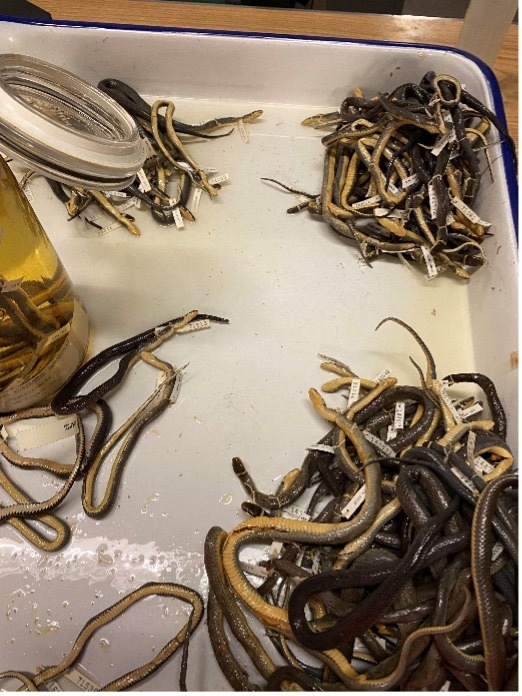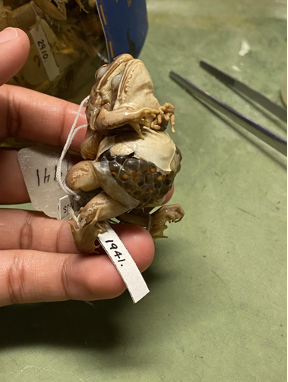by Jaylynn Smith
Curator note: We currently have an intern from a local high school working with us for ten weeks. The goal of the internship is to gain experience working on collections care and maintenance, learn about amphibian and reptile biology and taxonomy, and to create social media content related to this experience. Look for more content from our intern in the coming weeks!
The first week of my internship was completed! So far it has been a very enjoyable experience. The opportunity to be behind the scenes and learn hands-on about the different specimens that are held in the Alcohol House, and the way they are separated into their taxonomic families has been exciting.
Before my first week I had no knowledge of how these animals were classified or the way they were preserved. However, after the first few days I gained a bit more information on them, like the way they’re stored in 70% ethanol and how there are sections for each major group (frogs, snakes, turtles, etc.). This was very fun since I got more insight and learned more about the reptiles and amphibians I’d be working with. I also learned a bit about how to maintain and take care of the collection, such as testing the concentration levels in the jars and making sure it is at 70%, and also that each jar is filled all the way to the top so the specimens won’t dry out.

Additionally, we dove into checking the status of loans, a museum service which is very similar to the way libraries loan books. A researcher may borrow specimens for comparative study or to learn more about that specific animal. Once the borrowed materials are back in our care, we have to make sure every one of them has been returned safely. This sometimes means taking the specimens out of their jars and counting them all! (Figure 1) Doing this routine work gave me the chance to be up close with the specimens and more hands-on. I found it very interesting being able to touch the animals and see how different they are from each other, like the way patterns may differ on certain snakes or even seeing frog mating behavior (Figure 2)!

Not only do I have this great opportunity through this internship, I also can share much of the museum experience with my family as well with the benefits that come along with it. Over the weekend I went to the museum with my younger siblings, allowing them to learn more and broaden their knowledge of different animals from both the past and present. While we were there, we came across the Alcohol House Interactive exhibit in Discovery Basecamp, a display featuring information, images, and even actual specimens from the Alcohol House. This gave me the chance to tell my younger siblings about what I do in the Alcohol House. I was able to talk about the specimens I worked with so far and how fascinating it all has been just in the first week. Moving forward my goal is to learn even more about the animals that I’m working with and the process that goes into taking care of them. I also hope to do my own research on them and find answers to questions I may have. But at this point in time I am very optimistic and thrilled about the future of being an intern at the Carnegie Museum of Natural History.
Jaylynn Smith is an intern in the Section of Amphibians and Reptiles. Museum employees are encouraged to blog about their unique experiences and knowledge gained from working at the museum.
Related Content
Ask a Scientist: What is the creepiest specimen in the Alcohol House?
Do Snakes Believe in the Tooth Fairy?
An Illuminating Tale of Tracking Turtles
A Summer Internship at Powdermill
Carnegie Museum of Natural History Blog Citation Information
Blog author: Smith, JaylynnPublication date: June 15, 2021
